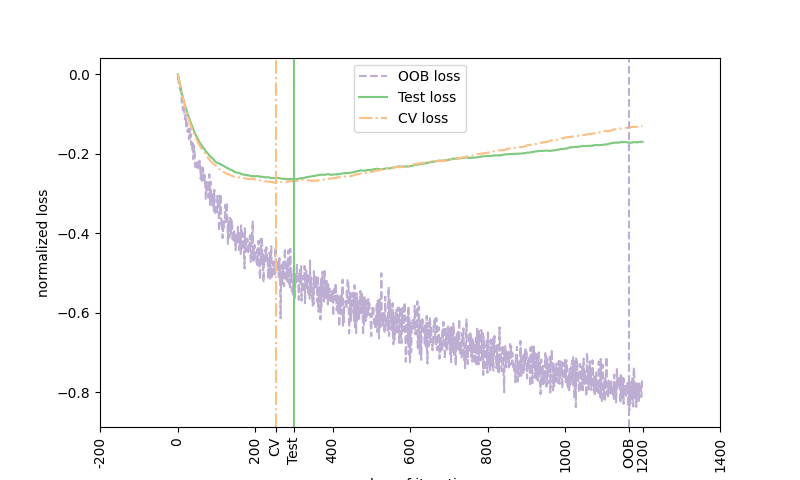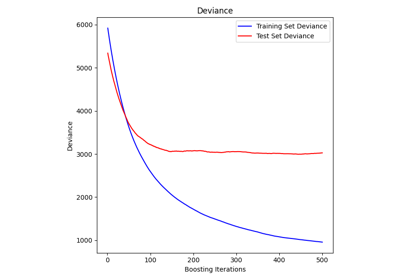Note
Go to the end to download the full example code. or to run this example in your browser via Binder
梯度提升袋外估计#
袋外(OOB)估计可以作为一种有用的启发式方法来估计“最佳”提升迭代次数。
OOB估计与交叉验证估计几乎相同,但可以即时计算,无需重复模型拟合。
OOB估计仅适用于随机梯度提升(即 subsample < 1.0 ),这些估计是基于未包含在自助样本中的示例(即所谓的袋外示例)的损失改进得出的。
OOB估计是对真实测试损失的悲观估计,但对于少量树来说仍然是一个相当好的近似。
图中显示了负OOB改进的累积和作为提升迭代函数的变化情况。正如你所见,它在前一百次迭代中跟踪测试损失,但随后以悲观的方式偏离。
图中还显示了3折交叉验证的性能,通常它能更好地估计测试损失,但计算要求更高。

Accuracy: 0.6860
# 作者:scikit-learn 开发者
# SPDX-License-Identifier: BSD-3-Clause
import matplotlib.pyplot as plt
import numpy as np
from scipy.special import expit
from sklearn import ensemble
from sklearn.metrics import log_loss
from sklearn.model_selection import KFold, train_test_split
# 生成数据(改编自G. Ridgeway的gbm示例)
n_samples = 1000
random_state = np.random.RandomState(13)
x1 = random_state.uniform(size=n_samples)
x2 = random_state.uniform(size=n_samples)
x3 = random_state.randint(0, 4, size=n_samples)
p = expit(np.sin(3 * x1) - 4 * x2 + x3)
y = random_state.binomial(1, p, size=n_samples)
X = np.c_[x1, x2, x3]
X = X.astype(np.float32)
X_train, X_test, y_train, y_test = train_test_split(X, y, test_size=0.5, random_state=9)
# 使用袋外估计拟合分类器
params = {
"n_estimators": 1200,
"max_depth": 3,
"subsample": 0.5,
"learning_rate": 0.01,
"min_samples_leaf": 1,
"random_state": 3,
}
clf = ensemble.GradientBoostingClassifier(**params)
clf.fit(X_train, y_train)
acc = clf.score(X_test, y_test)
print("Accuracy: {:.4f}".format(acc))
n_estimators = params["n_estimators"]
x = np.arange(n_estimators) + 1
def heldout_score(clf, X_test, y_test):
"""计算 ``X_test`` 和 ``y_test`` 的偏差分数。"""
score = np.zeros((n_estimators,), dtype=np.float64)
for i, y_proba in enumerate(clf.staged_predict_proba(X_test)):
score[i] = 2 * log_loss(y_test, y_proba[:, 1])
return score
def cv_estimate(n_splits=None):
cv = KFold(n_splits=n_splits)
cv_clf = ensemble.GradientBoostingClassifier(**params)
val_scores = np.zeros((n_estimators,), dtype=np.float64)
for train, test in cv.split(X_train, y_train):
cv_clf.fit(X_train[train], y_train[train])
val_scores += heldout_score(cv_clf, X_train[test], y_train[test])
val_scores /= n_splits
return val_scores
# 使用交叉验证估计最佳 n_estimator
cv_score = cv_estimate(3)
# 计算测试数据的最佳 n_estimator
test_score = heldout_score(clf, X_test, y_test)
# 负的oob改进累积和
cumsum = -np.cumsum(clf.oob_improvement_)
# 根据OOB的最小损失
oob_best_iter = x[np.argmin(cumsum)]
# 根据测试的最小损失(归一化使得第一个损失为0)
test_score -= test_score[0]
test_best_iter = x[np.argmin(test_score)]
# 根据交叉验证的最小损失(归一化使得第一个损失为0)
cv_score -= cv_score[0]
cv_best_iter = x[np.argmin(cv_score)]
# 三条曲线的颜色酿造
oob_color = list(map(lambda x: x / 256.0, (190, 174, 212)))
test_color = list(map(lambda x: x / 256.0, (127, 201, 127)))
cv_color = list(map(lambda x: x / 256.0, (253, 192, 134)))
# 三条曲线的线型
oob_line = "dashed"
test_line = "solid"
cv_line = "dashdot"
# 绘制最佳迭代的曲线和垂直线
plt.figure(figsize=(8, 4.8))
plt.plot(x, cumsum, label="OOB loss", color=oob_color, linestyle=oob_line)
plt.plot(x, test_score, label="Test loss", color=test_color, linestyle=test_line)
plt.plot(x, cv_score, label="CV loss", color=cv_color, linestyle=cv_line)
plt.axvline(x=oob_best_iter, color=oob_color, linestyle=oob_line)
plt.axvline(x=test_best_iter, color=test_color, linestyle=test_line)
plt.axvline(x=cv_best_iter, color=cv_color, linestyle=cv_line)
# 在xticks上添加三条垂直线
xticks = plt.xticks()
xticks_pos = np.array(
xticks[0].tolist() + [oob_best_iter, cv_best_iter, test_best_iter]
)
xticks_label = np.array(list(map(lambda t: int(t), xticks[0])) + ["OOB", "CV", "Test"])
ind = np.argsort(xticks_pos)
xticks_pos = xticks_pos[ind]
xticks_label = xticks_label[ind]
plt.xticks(xticks_pos, xticks_label, rotation=90)
plt.legend(loc="upper center")
plt.ylabel("normalized loss")
plt.xlabel("number of iterations")
plt.show()
Total running time of the script: (0 minutes 4.863 seconds)
Related examples

sphx_glr_auto_examples_ensemble_plot_gradient_boosting_regularization.py
梯度提升正则化




